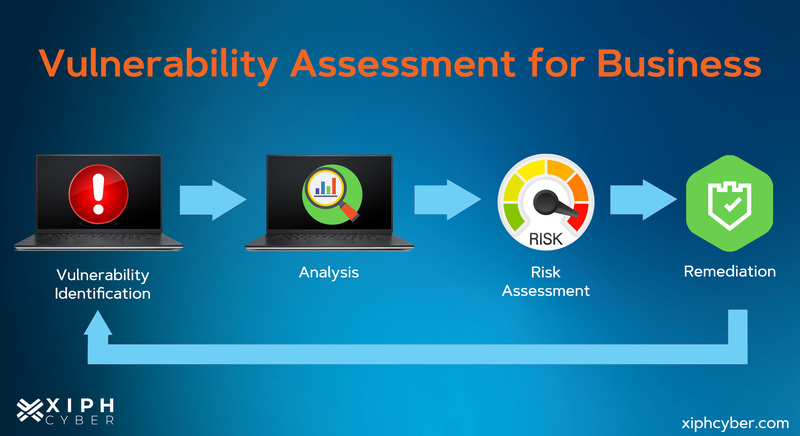Published Jan 05, 2023 by Xiph
Identifying potential loopholes and repairing weaknesses in your business’ IT environment is easier than dealing with the consequences of those weaknesses, such as a data breach or full-blown cyber attack like a denial-of-service (DoS) attack. That’s why conducting regular vulnerability assessments is important. This can help your organisation assess hardware and software assets, identify vulnerabilities, and put in place plans to mitigate/eliminate those cyber risks to prevent hackers from catching you off guard.

What is a vulnerability assessment?
A vulnerability assessment (also referred to as a vulnerability analysis or testing) ─ is a systematic review of security weaknesses and vulnerabilities within your business network or infrastructure. Vulnerability testing helps organisations pinpoint any vulnerabilities in their software and supporting infrastructure before they can be exploited by malicious actors and cause harm to your business. Common examples would be coding errors or flaws in software design, a gap in security procedures, or a weakness in internal controls, etc. The primary goal of a vulnerability assessment is to identify these vulnerabilities, document them, report them to the business, and provide details on how to resolve the issues.
How does a vulnerability assessment work?
The vulnerability assessment process involves locating, identifying, classifying, and prioritising vulnerabilities or security-level defects on computer systems, applications, and network infrastructures. Most organisations typically use a variety of tools, methodologies, and scanners to identify vulnerabilities, threats, and risks. These tools create an inventory of all IT assets (including servers, desktops, laptops, firewalls, printers, etc.) connected to a network, as well as any applications, software and programs that run on that network.
Vulnerability testing consists of several steps, including:
- Defining and classifying network or system resources from least to most critical
- Identifying potential threats to each resource, ranging from critical software design flaws to simple misconfigurations of applications
- Developing strategies to deal with the most serious threats first to the least critical
- Documenting all vulnerabilities to help developers easily identify and reproduce those findings
- Assisting developers in remediating the identified vulnerabilities
- Defining and implementing ways to minimise the impact of a potential cyber attack
.jpg)
Five types of vulnerability scanners
Vulnerability testing involves using automated network security scanning tools to scan, identify and report vulnerabilities in an assessment report for your business to consider. Vulnerability scanners can be categorised based on the type of digital asset(s) they scan:
1. Network scanners
Network-based vulnerability scanners identify all active devices and systems on a network. Network administrators scan your network to evaluate IP addresses and detect live hosts connected to it to help determine if there are unknown perimeter points on the network, such as unauthorised remote access servers, or connections to insecure networks of business partners.
2. Host-based scanners
Host-based vulnerability scanners locate and identify vulnerabilities of local machines, servers, and other network hosts to provide greater visibility of configuration settings and patch history of scanned systems (even legacy systems) and identify any vulnerabilities.
3. Wireless scanners
Wireless vulnerability scanners are used to identify rogue access points to your organisation’s Wi-Fi networks, and other IoT vulnerabilities, and to ensure your network is securely configured.
4. Application scanners
Application vulnerability scanners can identify software vulnerabilities and unsound configurations of your network or web applications. Application scanners work similarly to search engines and ‘crawl’ through websites by sending a range of probes to each web page to look out for security weaknesses.
5. Database scanners
Database vulnerability scanners identify the weak points in a database to prevent malicious attacks like SQL injection attacks.
Why is vulnerability testing important?
Vulnerability testing is essential for identifying potential risk areas in your cyber security, providing your business with a detailed overview of all security weaknesses in its IT environments. It also helps your organisation quickly mitigate potential threats before they materialise and impact your business operations, assets, bottom line, or reputation (or all combined).
Regular vulnerability assessments provide your business with a better understanding of its assets, security flaws and overall cyber risk profile, thus reducing the likelihood of cyber attacks and impacts on your business.
Vulnerability assessment vs penetration testing
A vulnerability assessment often includes a penetration testing component, but these two concepts are distinctively different. Vulnerability testing is an automated high-level test that identifies, quantifies, and ranks vulnerabilities in your organisation's computer systems or networks and then reports them. Meanwhile, penetration testing (also known as a pen test or ethical hacking) involves employing certified ethical hackers to conduct a simulated attack on your systems, applications, or IT environments, to identify security weaknesses that may not be picked up by other network or system scans.
How to implement vulnerability testing in your business
Small businesses should conduct a scan of their internal and external systems at least bi-annually, while larger enterprises should aim for quarterly.
Implementing vulnerability testing in your business will typically involve some type of asset discovery and locating where they reside on your digital infrastructure and its connected devices. Then, it’s a matter of determining which systems and networks the vulnerability assessment will review, including cloud, IoT, and mobile devices. This will include locating where sensitive data is stored and determining which subsets and systems are most critical.
Read more: What is cloud storage & is it safe?
Once you’ve identified all your network or system resources and classified all these assets from least to most critical, you can start vulnerability scanning using both manual and automated tools, as well as penetration testing. Vulnerability scanners help both identify security weaknesses and provide guidance on how to remedy them.
Finally, once all vulnerability scans are complete, your organisation should get a detailed assessment report outlining your risk score and vulnerabilities based on severity. For example, vulnerabilities of internet-facing systems would be higher on the priority for remediation because they can be exploited by any random hacker scanning the internet. A good vulnerability scanner will also suggest timelines for when to fix each issue, as well as guide the best way forward.
A final word
Cyber weaknesses are aplenty especially considering the complexity of any organisation’s digital infrastructure, which means your business may have one or more unpatched vulnerabilities that pose a cyber risk. Conducting regular vulnerability assessments can identify potential threats before hackers do and help mitigate them, therefore bolstering your organisation’s cyber security. For more information on how to best implement vulnerability testing in your business, contact us via email: enquiries@xiphcyber.com.
Posted in: Security


